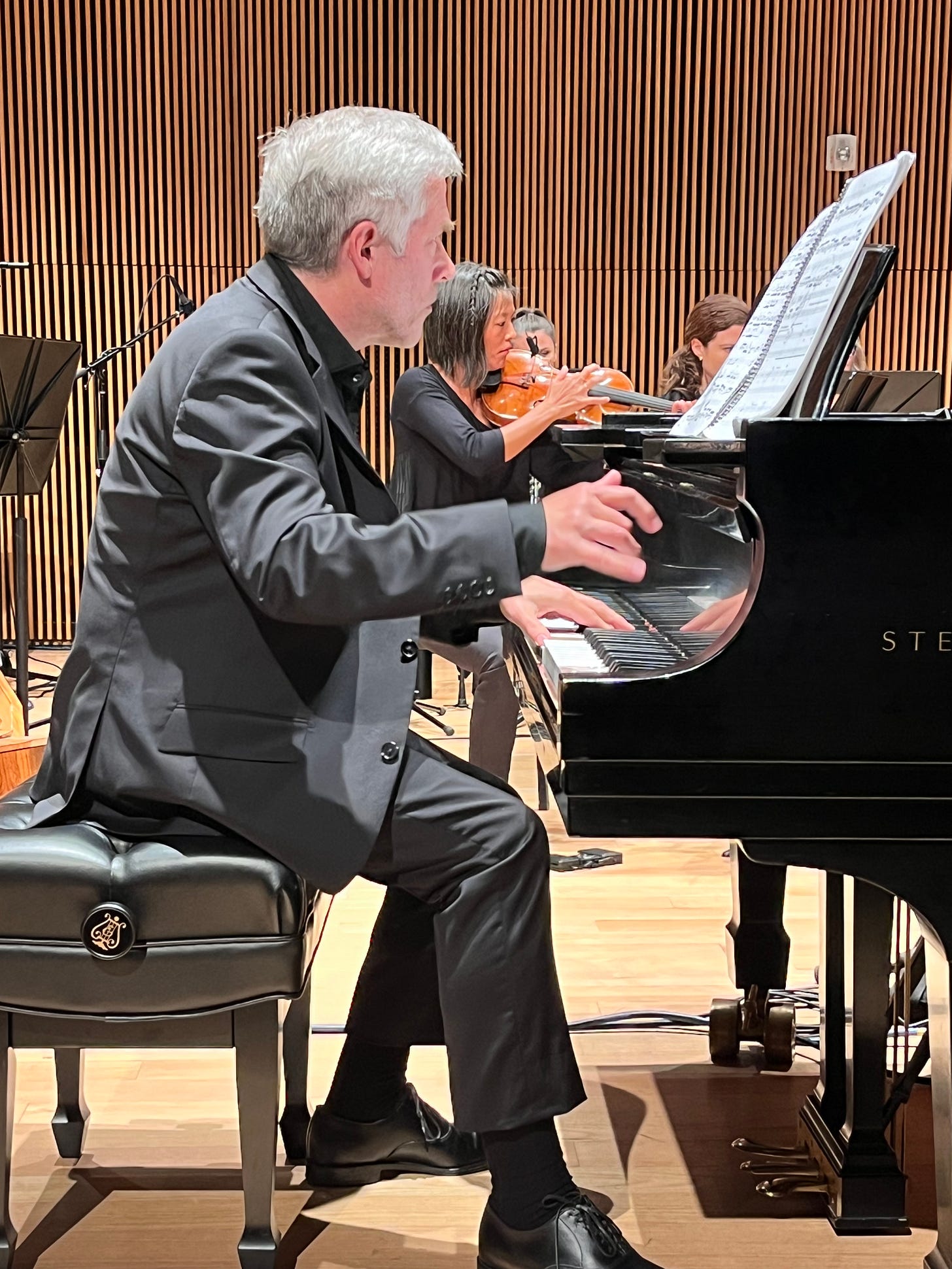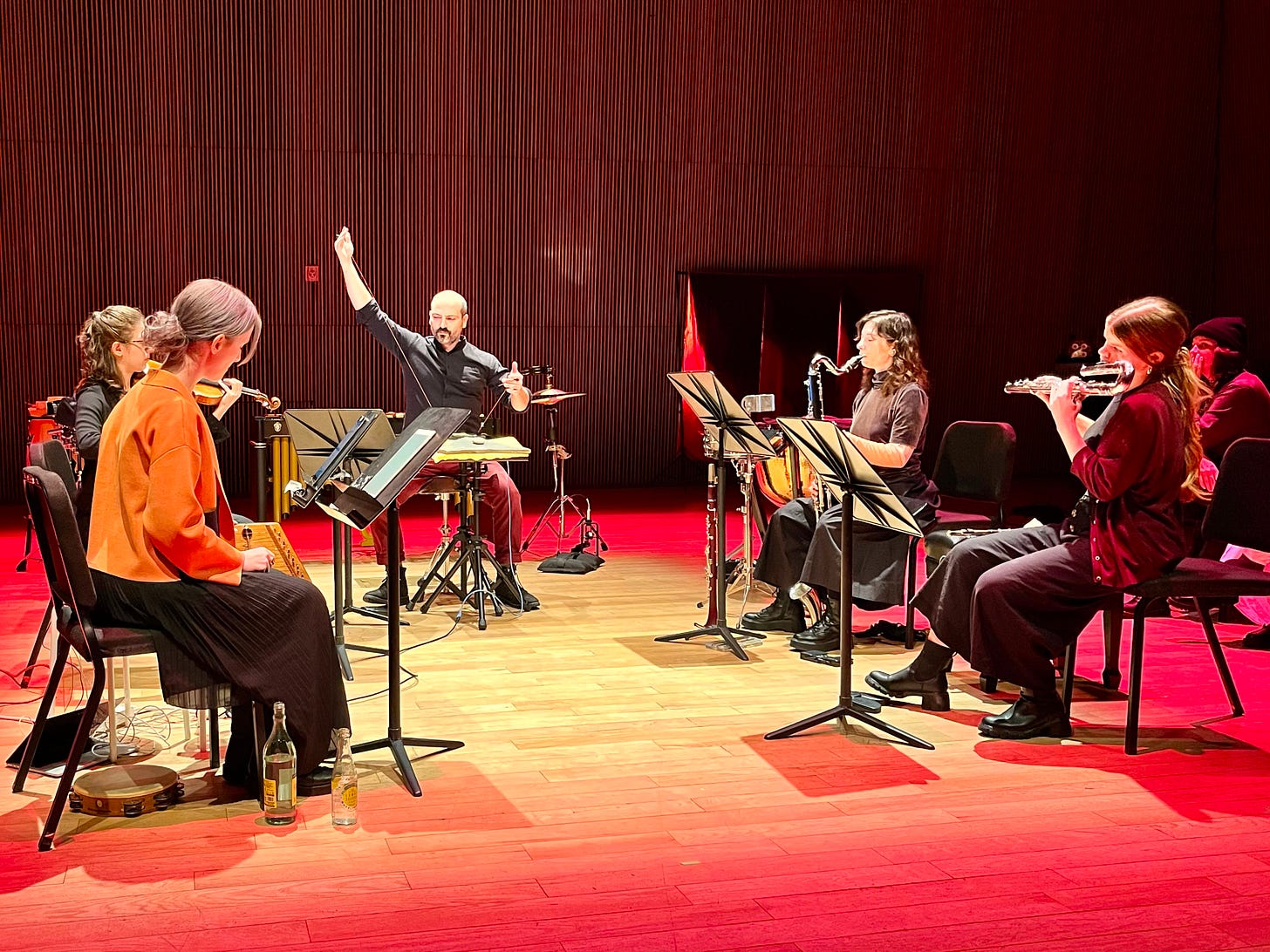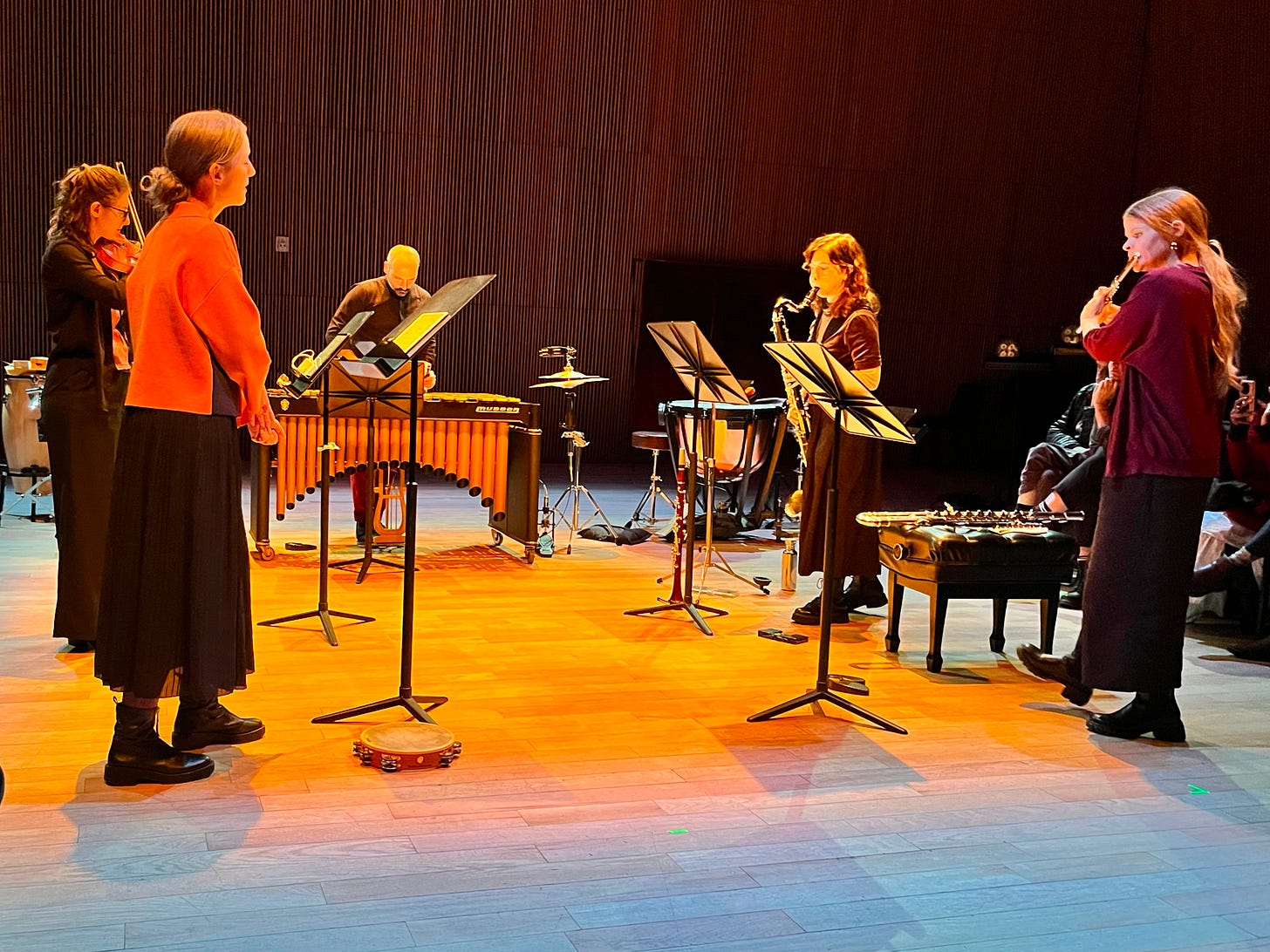Live Log 2024: Talking Talea and Tak
Four concerts from recent months put the vitality and excellence of the contemporary music scene on full display
The year is nearly over and it’s time to make those best-of lists everyone loves. But I have fallen behind on my pledge (mostly to myself) to plant a flag for the concerts I see, using the Live Log to ensure they don’t just disappear into the ether of passing time. I especially wanted to talk about the four shows below, all of which put the vitality of contemporary composition to the fore along with the sheer excellence and passion of two of our finest ensembles.
Talea Ensemble at Time:Spans
This two-week festival was once again a highlight of August’s concerts, with every concert promising great things. I managed to make to two of them, both featuring the Talea Ensemble.
Night One: August 18, 2024
Believe it or not, this was the third time I brought baked goods to a band. Back in the 2010s, I became friends with the post-punk band Breton. After seeing enough of my baking on Facebook, they requested an infusion, which I duly delivered to them at Glasslands. Then there was the time a potluck was attached to a Holly Miranda concert. Brownies again!
This time, I offered bar cookies as my contribution to Talea Ensemble’s silent auction and the winning bid went to composer and fellow Talea board member, Steven Kazuo Takasugi. Since he was in town for the New York premiere of his Piano Concerto, it made sense for me to bring a couple dozen bar cookies to rehearsal and share them with the ensemble. Maybe he was hoping they’d forgive him for this demanding piece.
I had a literal front-row seat to watch just how demanding as they ran through the final rehearsal. While they worked through fragments of fragments, I was astonished at everyone’s commitment and attention to detail, especially that of soloist Roger Admiral. Takasugi was laser-focused, too, at one point worrying about tiring the audience’s ears with a too-bright piano sound. He reversed one of the microphones in the piano, which combatted the harshness to his satisfaction. There were at least 14 microphones across the stage as the work was being recorded for future release.
While the concerto was premiered in Europe, we were about to hear a newly created Sinfonietta version, so in a way, this was another world premiere. In addition to arranging the piece for smaller forces, Takasugi added a new fixed media component that differs from the one used in the orchestral version.
After working out the kinks, the ensemble broke from rehearsal and dug into the bar cookies, everyone happy to have fuel for the performance to come. Eventually, I left them to their final preparations and repaired to Longo Brothers for a cocktail.
While I had an inkling of what to expect from the rehearsal, Takasugi’s piece still blew my mind, with its sheer density giving me strong Edgar Varese vibes. The creator of Poème Electronique likely would have been pleased to hear how Takasugi shadowed Admiral's piano with another on the recording. Having seen Takasugi talk about the work as a reflection of modern anxiety, the doubled piano was also a reminder of how perilously difficult it is to live without a digital doppelgänger these days.
There was no warm-up, either, just everything all at once, instruments piled upon each other in layers. In the first movement, different types of anxiety were created by ascending and descending drones, with the former ramping up the tension and the latter creating that sense of doubt familiar from David Bowie’s piece of the same name.
The second movement began with sustained backing from strings and woodwinds, Admiral tapping out a Morse code near the top of the keyboard, fingers becoming a blur. Gradually other instruments stole in, with percussionist Sae Hashimoto rubbing her hands on the skin of her side drum, as if in a resurrection rite. Then she bowed a high-pitched drone on a wine glass and things got even eerier. All the while, Admiral’s Morse code continued, eventually leading to bravura playing all up and down the keyboard, the ensemble roaring along at shattering volume that never overwhelmed the furiously complex inner voicings.

The performance was a triumph from start to finish and Takasugi should be commended for injecting a bolt of pure energy and invention into the well-trodden ground of the piano concerto. Hopefully, all those microphones will result in a recording we can share with the world.
Night Two: August 20, 2024
Talea’s second night at Time:Spans couldn’t have been more different than the first. For one thing, there wasn’t a private open rehearsal so I made sure to get there early enough to get a decent seat to the sold-out concert. I was surprised to find a small group of Talea die-hards waiting outside the hall. I decided to do a little market research and asked them what the draw for the show was. “It’s the composers, isn’t it?” one man answered. “I come for the wine,” said another, holding up a little plastic cup. And that was all I learned before the doors were opened and we all dashed for the front row.
The other big difference was that instead of performing one piece, Talea would be presenting six in what Executive Director and bassoonist Adrian Morejon called “A complicated evening” built around Alec Hall’s 2017 piece, Vertigo. The six works were also linked by their connections to various recording workshops and residencies at Harvard, Columbia, and others. After reading the program notes, the elderly gent to my right also perceived a connection of his own: “Only one of these is about music,” he said to his companion. Before I could ask more, the lights went down and the concert began. Here are some quick impressions of the fascinating music that ensued.
Sivan Cohen-Elias - Still Life with Squares (2014) Opened with sleepy sounds from the cello and spare, random sounds from the flute, piano, violin, and percussion, with occasional drama. The machine got going in a lurching fashion, interrupted by a solo for sheet metal. The other instruments joined in eventually. Sivan reworked the electronics since the premiere and they sounded dimensional and sharp. Performative elements, such as the cellist drawing squares with their bow, are meant to convey “a world of squares that have gotten out of control.”
Sasah J. Blondeau - Etat d’exception (2014) The electronics shifted from silvery to static while the piano sparkled, with bells for punctuation. At the end, a voice and the sounds of running water created a brief sense of narrative, possibly autobiography.
David Bird - Moln (2019) Named after the Swedish word for cloud and inspired by the radioactive plume that led to the outside world discovering the Chornobyl accident, this piece was adapted from a flute piece called Multiplicities. Not surprisingly, the bass flute, played by the wondrous Laura Cocks, often takes center stage, presenting as agitated and percussive at the beginning. Bass clarinet, string quartet, percussion, and multi-channel electronics soon enter, sometimes in argument, at others in conversation. The percussion helped build tension and added sonic depth. Even during the first listen, I could detect a shape to the piece, which will surely reveal itself more on further listening.
Uri Kochavi - dermis (2024) This collage-like piece had layers that seemed to go on forever. In addition to the large ensemble (flutes, clarinets, bassoons, string quartet, percussion, and electronics), there were also “DIY objects” and spatialized metal sheets, leading to wild sonic inventions made by tubes, penny whistles, and more.
Shasha Chen - The Bee Is Present (2022) While the ideal performance of this work is accompanied by the release of a live bee into the room, we had to make do with the mere suggestion of an apian presence. At the start, the tightly orchestrated group of flute, violin, bassoon, and cello sounded stern and angular, but collaborative. There are rhythmic twangs that propel the piece forward. Overall, Chen’s piece is short and tart, illustrating what she called “the musicality of action” and the consuming nature of fear.
Alec Hall - Vertigo (2017). Inspired by Hitchcock’s film and the experience of instability due to dizziness - and the politics of 2017, “when the Trump presidency was starting to blossom into full insanity-mode.” Not surprisingly, there was high drama throughout the piece along with subterranean rumbles, choreography, and metronomes. Hall put a sonic interpretation to the famous “dolly-zoom effect,” and employed tick-tock tension and shattering explosions in a seeming homage to Hitchcock’s composer, Bernard Herrmann. The piece grew more cinematic with a swirling harp, police whistles, a revving engine, and sirens. Vertigo and Varese were intertwined in this fascinating piece, ending the evening in bravura fashion.
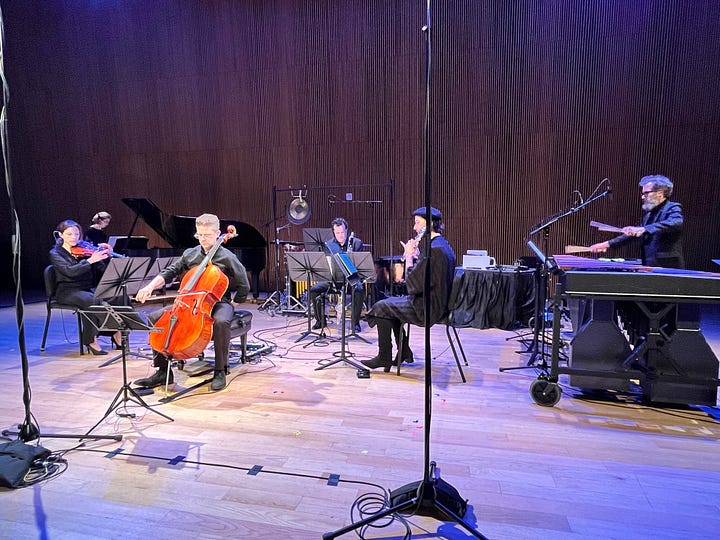

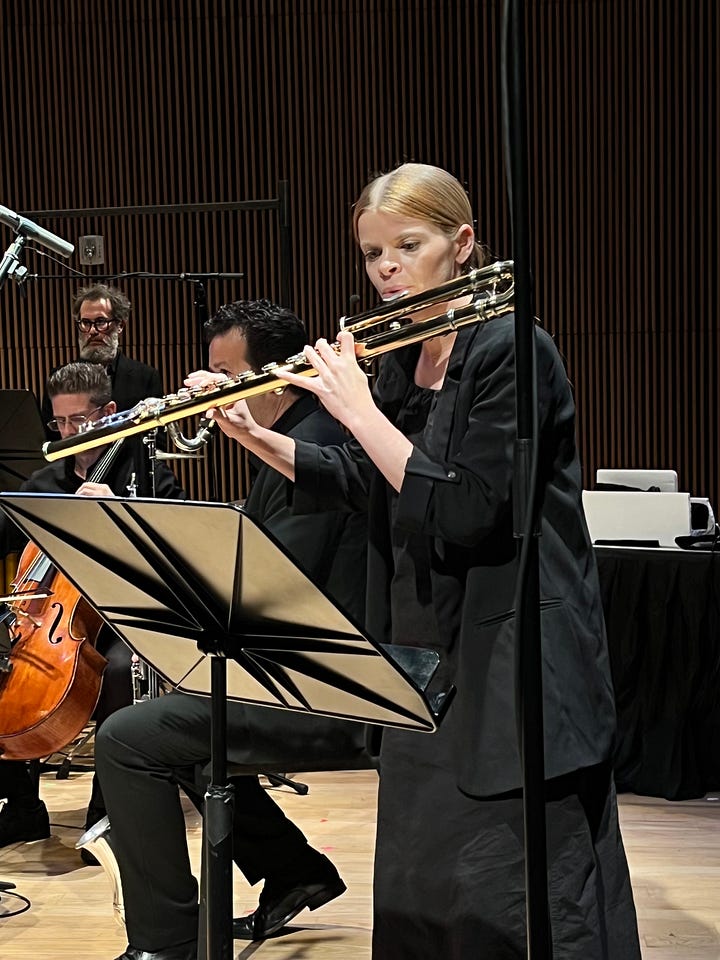

Tak Ensemble: Bookends
I made it to two concerts in the Tak Ensemble’s amazing season, from the season opener in September to the year-ending show earlier this month.
September 22, 2024
Here are some scenes from the Tak Ensemble’s “haunted” season opener at Roulette, featuring world-premiere performances of two pieces by Seth Cluett.
The first, the reformation of assemblages, took place on the screen in a video filmed in Prospect park with choreography by Abigail Levine and cinematography by Itziar Barrio. It was an immersion in mediated nature, with the answers to new koans presented, such as what is the sound of a feather on a pebble? The greenery dazzled as members of the ensemble along with dancers and members of the technical crew moved through it, some making sounds with repurposed natural elements with captivating results.
The second, Irreversible histories of disturbance, featured handmade instruments (fan-powered slide whistles, spring-pipe mono chords, etc.) alongside clarinets, flutes, violin, vocals, and percussion, with everything working together to create a sense of time suspended. And also suspense, as you waited for the various items on stage to be employed in making sounds. Perhaps the scene-stealer was a contraption made of leaves and twigs that moved and rustled, creating an artificial “field recording.” At one point it seemed to get stuck, so percussionist Ellery Trafford poked at it with a drum stick until it started moving again.
When the piece was nearing its conclusion, the players began subtracting elements, shutting off various drones. It was only then that I realized how much had been going on within what sounded like a seamless shimmer. Cluett is not shy of requiring intense concentration on the part of both players and audience, but the transporting results spoke for themselves.
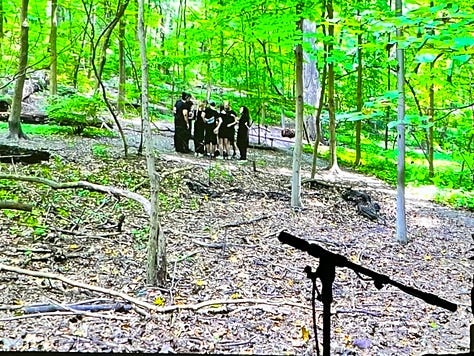
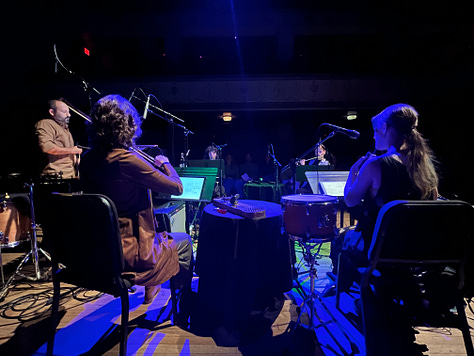
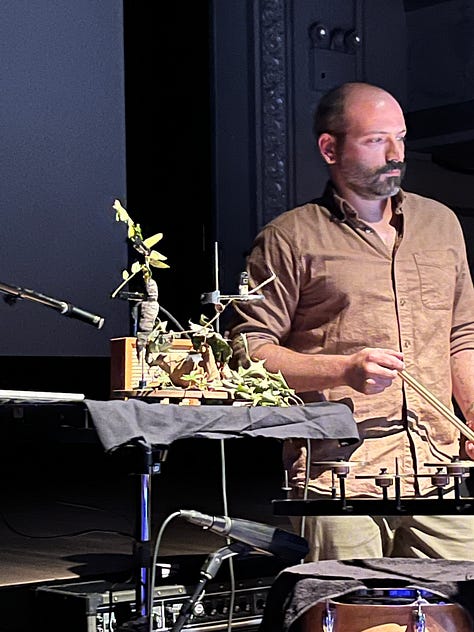
December 3, 2024
To close out their 2024, Tak put on an extraordinary show at the Dimenna Center, packing Cary Hall with a rapt audience.
The evening opened with METANOIA, a solo performance by friend of the ensemble Qiujiang Levi Lu, a Beijing-born, NYC-based performance artist and composer of surpassing skill and passion. Arthur C. Clark famously stated that “Any sufficiently advanced technology is indistinguishable from magic,” but even he would have been astonished as Levi Lu’s body-augmenting electronics allowed them to emit a kaleidoscopic array of sounds. Some of these were produced by knocking two wooden sticks together - or on their body, creating thunderous echoes, while others were generated by his mouth, cyborg-like shrieks, growls, and melodic fragments. The piece only gained in stature the longer it went on, Levi Lu stalking the stage in their underwear, blindfolded, becoming slick with sweat and pulling faces that made some connection with my limited knowledge of the Chinese theatrical tradition. Jaw-dropping stuff.
Tak’s set was called HOLDING and featured four pieces, starting with Bring me your silence by Seare Ahmad Farhat. The elements included Marina Kifferstein’s breathy violin, Ellery Trafford striking stone on stone and manipulating a re-purposed video golf controller, Madison Greenstone ululating on the bass clarinet, Charlotte Mundy blowing across bottles and singing, and Laura Cocks gently giving voice to her flute. It was a fragmentary work, but it did ebb and flow with oblique drama, echo effects emerging from Mundy striking a contact-miked zither, which provided an otherworldly atmosphere that only enhanced her wordless vocals.
Zeynep Toraman’s veils followed, feeling somehow derived from a folk song, half-remembered over the centuries and rendered diaphanous by time. Shivery sounds from a bowed snare drum accented the hypnotic consonance from the voice, violin, clarinet, and flute. All seems to occur on the exhale and it grows more spectral and inert as it goes on. Eventually it just stops and we can finally inhale. I’ve been hungry for more from Toraman since hearing AndPlay’s world-premiere of her Slow Poem and veils did nothing but make me more of a fan.
The third piece was form the fabric by inti figgis-vizueta. An incantatory beginning, growing more unhinged, with vocal shrieks and guttural noises, leading to distortions from the bass clarinet. The violin and flute became locked in an eternal argument while the marimba maintained a cool detachment. Eventually, even that grew agitated and the piece hit a fever pitch before everyone dropped out except the violin, Kifferstein’s bow spitting out the same enraged fragment over and over. Everyone returned, seemingly chastened, taking a turn towards the silvery and spare before ending.
Finally, we were treated to ROOT AND VEIN (quintet as solo), excerpted from Eric Wubbels’s interbeing. It was rhythmic and jagged, full of wild yells and calls from the ensemble. Patterns assembled and then broke apart, the rhythm becoming implied as the marimba sparkled. More jaggedness and then everything becomes unexpectedly lovely. After a long reverie, the patterns began to tighten and the rhythm grew insistent again. The four-four beat soon morphed into a polyrhythmic swirl and we were soon in a songlike and repetitive realm not unlike a more aggressive Penguin Cafe Orchestra.
It was a thrilling way to end the performance and earned the Tak Ensemble a lengthy standing ovation. A year-ending celebration with wine, cheese, and snacks (but no bar cookies…) gave everyone an ample opportunity to congratulate the composers and performers, brave artistic adventurers all.
What will 2025 bring for Tak and Talea? Whatever it is, it’s guaranteed to be amazing!
From the archives:
Live Log 2024: Tak Ensemble Takeover
Live Log 2023: Written For Talea





